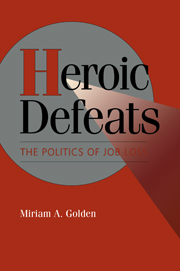Book contents
- Frontmatter
- Contents
- Preface
- List of Abbreviations
- Chapter 1 The Puzzle of Union Responses to Workforce Reductions
- Chapter 2 Games Analyzing Job Loss
- Chapter 3 Job Loss in the Italian and British Automobile Industries
- Chapter 4 Triggers of Industrial Action
- Chapter 5 Pit Closures in the Japanese and British Mining Industries
- Chapter 6 Seeking Allies: How Other Actors Affect Interactions over Job Loss
- Chapter 7 Conclusions
- Notes
- References
- Index
Chapter 1 - The Puzzle of Union Responses to Workforce Reductions
Published online by Cambridge University Press: 20 January 2010
- Frontmatter
- Contents
- Preface
- List of Abbreviations
- Chapter 1 The Puzzle of Union Responses to Workforce Reductions
- Chapter 2 Games Analyzing Job Loss
- Chapter 3 Job Loss in the Italian and British Automobile Industries
- Chapter 4 Triggers of Industrial Action
- Chapter 5 Pit Closures in the Japanese and British Mining Industries
- Chapter 6 Seeking Allies: How Other Actors Affect Interactions over Job Loss
- Chapter 7 Conclusions
- Notes
- References
- Index
Summary
Threatened with the bankruptcy of their employer in 1979, a majority of workers in Chrysler plants in the United States voted for major concessions in wages and benefits in an attempt to reduce the company's need for workforce reductions. Nonetheless, by so doing, employees tacitly endorsed the subsequent firings of thousands of their fellows. Faced with a similar situation a year later, autoworkers in Turin, rather than negotiating concessions, held out for 35 days in a strike against Italy's largest private employer, Fiat, a strike that paradoxically only intensified after the firm retracted its threat to effect forced dismissals and proposed temporary layoffs in their place. At the same time, neighboring Olivetti plants were laying off thousands of employees with the active cooperation of the very same union that was making national headlines with its dramatic industrial action at Fiat.
A year earlier, British autoworkers had already conceded that largescale workforce reductions would be required were British Ley land to recover profitability and competitiveness. Just a few years later, by contrast, British coal miners decided to battle pit closures in a year-long strike that opened in 1984, a strike garnering international attention as the country's most severe and bitter since the General Strike of 1926. Paradoxically in this case too, the 1984–85 miners' strike occurred despite repeated assurances from the National Coal Board that no miner would suffer involuntary job loss.
- Type
- Chapter
- Information
- Heroic DefeatsThe Politics of Job Loss, pp. 1 - 27Publisher: Cambridge University PressPrint publication year: 1996



